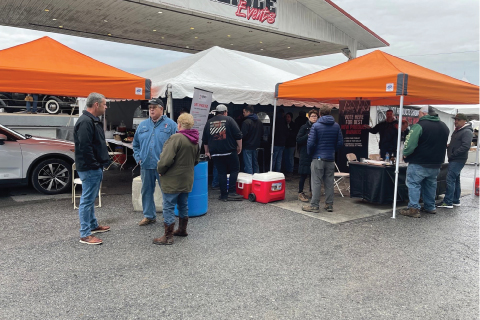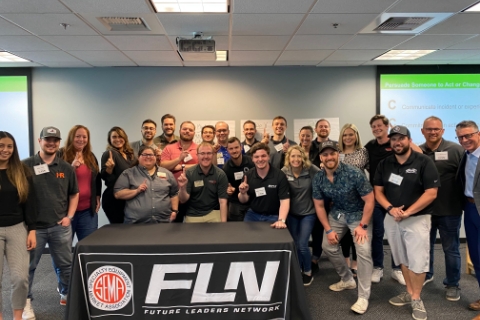SEMA Member News—July 2019
New Directions: Trends in Restoration
Not many years ago, the term automotive restoration typically conjured images of vintage vehicles lovingly restored and brought back to life true to their original condition. Recently, modern technology and innovation have made inroads into the restoration marketplace, spawning a growing interest in restomods upfitted with modern-day modifications yet still retaining their classic look.
So what does this mean for the future of the restoration market? For insights into how this trend and other factors are influencing the restoration industry, SEMA Member News reached out to ARMO select committee members Tray Smith (council chair and president as well as CEO of H&H); Amy Fitzgerald (co-owner of Cool Hand Customs); and Keith Roberts (marketing manager for Distinctive Industries).
 |  |  |
| Tray Smith from H&H, IPC of ARMO | Amy Fitzgerald from Cool Hand Customs | Keith Roberts from Distinctive Industries |
SEMA Member News: Tell us about your involvement in the industry and your company.
Tray Smith: I have been involved in the automotive industry since I was born. I literally grew up in the industry. My father had a full-line auto service center and a full-line jobber parts store before he started H&H. I came back to H&H in 1995. We manufacture 400 items and offer more than 25,000 items. We cover restoration, restomods and custom parts for Tri-Fives, Chevy/GMC trucks, Impalas, Chevelles, Novas and Camaros.
Amy Fitzgerald: Cool Hand Customs is a two-person, full-service auto shop. We specialize in customizing, restoring and restomodifying pre-’80 vehicles. We do everything from the frame up—mechanical, wiring, motor, drivetrain, paint, interiors and so forth. We started our business in 2008. With a toddler at home and our house on the line, we closed our remodeling business and took out a small loan to start [the company] in our 400-sq.-ft. garage. Within 18 months, we purchased our current 4,000-sq.-ft. location.
Keith Roberts: I have worked in the industry for 20 years. I currently work at Distinctive Industries as the marketing manager/sales rep. We manufacture restoration interior products for ’60-and-later Ford and General Motors classic cars and trucks.
SMN: What trends are you seeing in the restoration market/hobby?
TS: We continue to see restomods as the dominant type of restoration being done. The purist is in the minority, for sure. As for types of cars or trucks being built, trucks are the top brand sellers for us, and ’73–’87 square-body trucks are quickly becoming a force in the market.
AF: Our customer base definitely leans toward the restomod build. We build vehicles that still have the old look and feel, but our customers want modern, more reliable and safe motors, drivetrain, lighting and electronic amenities. Our main customer demographic is men over 40. We have very few female customers unless they are spouses. I make a point of trying to bring the wives into the shop and get them involved. And many of them start to take a greater interest in the vehicle and even enjoy car shows more when they have gotten to be part of the process.
KR: The biggest change is the shift from a stock restoration interior to an upgraded stock-like interior. One of our better-performing product lines is our Touring II seats. They come assembled, bolstered and wrapped in restoration upholstery that mimics the stock upholstery and will match the rest of the interior. The seats bolt directly into the car and perform better than a factory seat. I would imagine that other companies in the restoration market have noticed a similar situation in their product offerings, as well. I feel that most restorers are looking for a product that gives a nod to the original stock design but uses modern technology to give you a better-performing product.
SMN: How do you see the restomod fitting into the restoration segment? When does it become a hot rod?
TR: Restomod is the force that is driving the market, so that has really blurred the lines between restoration and hot rod. In my mind, the restomod is more about upgrades to a car or truck that’s restored or being restored: brakes, gauges, A/C systems, maybe wheels. When you start talking about upgrading engines, suspension or airbags, I think it moves into the hot-rod world.
Something that is being left out is the custom car. Some people are going to say that’s in the same class as a hot rod. I disagree. Look at the custom cars that Ryan’s Rod and Custom is building, such as the Lincoln we had in the booth at the SEMA Show last year. That is a custom car—a throwback to the ’60s cars of Gene Winfield and Darryl Starbird—and guys like Chris Ryan are keeping that alive.
AF: My husband and business partner’s definition of a hot rod is a vehicle that’s modified for performance purposes only. He says that if it doesn’t make it go fast and look good, it doesn’t qualify as a hot rod.
When I think hot rod, I think of horsepower but more about custom. I define restomod as taking the old and retrofitting with the new. Restomod is the happy medium between restoration and customizing. Our customers want a daily driver they can drive anywhere and win a few awards at car shows. We have been pretty successful in that segment of the market.
KR: I think the lines between restoration and restomod are getting very blurred. I think a restomod is a form of restoration and has its place in the restoration industry beside a traditional restoration.
SMN: Do you see anything on the horizon that could be the next thing in restoration?
TS: The builders and market will keep pushing the envelope in restomods and hot-rod lines. There will always be the pure restoration with some cars that are unique and very rare. But builders will always look at what is the next thing that the OEMs are doing and how they can stuff it in a Chevelle, a Tri-Five, a truck or whatever they are building. We will start seeing hybrids and full-on electrics at some point in the future. I can’t say that I’m a fan of those, but there will be someone who will try it and build a show car. So I think you have to be tolerant and accepting of new ideas.
AF: I think the restoration segment will continue to grow and flourish. I hope to see the next generation of enthusiasts continuing to incorporate modern safety and performance components into the classics. That is where the market is going.
I also think vehicles that weren’t heavily sought-after—four-doors, wagons, etc.—will make a huge comeback. They are the bulk of what’s left in junkyards and hidden in barns. Regardless of the desire for a vehicle to perform like a modern vehicle, enthusiasts still want it to look and feel like a classic.
KR: With manufacturers offering products that can fit both restoration and restomods, I think this will continue to be a big debate in the restoration industry.








